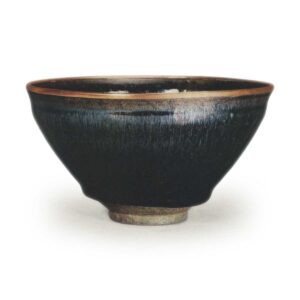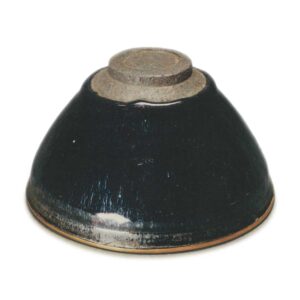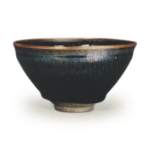

Height: 7.2cm
Diameter: 12.4-12.6cm
Outer diameter of foot ring: 4.0cm
Height of foot ring: 0.7cm
The Kōme, or Usugōzan, is the most common of the Kenzan types, and is a typical example of the Kenzan style. However, there are actually not many beautiful, jet-black, highly-glossy tea bowls like this one, as there are surprisingly many examples of tea bowls that have been fired to a tea-colored hue or have a dull glaze.
First of all, in terms of the shape of the bowl, this tea bowl is a good example of all the basic forms of Ken-zan, and it also has an extremely elegant appearance.
The bowl shape has a tight, well-rounded feel, and the foot is small with a turned-up rim. The rim is hidden by a gold border, but judging from the overall shape, it is probably made with a thin, sharp rim. The foot ring and the side-taking are very carefully made, and the inside of the foot ring is shallowly carved and finished in a snail-like pattern. The clay is a grayish black color and is tightly fired.
The inside and outside are covered in a glossy black glaze that looks like obsidian, and the glaze on the outside is cut off horizontally at the waist, creating a thick glaze pool. The part near the mouth has a reddish tinge as the glaze flows and becomes thin. The bottom, by contrast, has a bluish tinge, but this is a phenomenon that is often seen in Kenzan.
The glaze surface is covered with countless fine, silver-colored vertical streaks, which overlap each other in layers.
This is called “kome-me” in Japanese, and “tou-gao-zan” in Chinese. It is thought that the iron in the black glaze forms fine crystals, which appear as streaks as the glaze flows. In this teacup, it appears in subtle shades of blue and white, and it seems to approach the luster seen in yohen.
This is probably because the crystal particles are very fine. There are no ha-me on the inside of the cup, and there are a few very small air bubbles scattered on the glaze surface, and there are also faint bluish patches.
Above all, the attractive thing about this piece is the way the glaze’s glossy jet-black color is dotted with the marks left by the wok, and the beauty of the interior is outstanding. It is fair to say that this piece best demonstrates the beauty of the wok marks.
The place of production is, of course, Jian ware from the Jian kilns in Fujian Province. The date of production is thought to be the 12th or 13th century. Recently, it has been reported that a bowl with a black glaze was excavated from a tomb in the suburbs of Taiyuan City in Shanxi Province, China, which is thought to date from the end of the Northern Song dynasty. The shape of the bowl is similar to this type of Jian ware, so it is not necessarily unreasonable to say that the upper limit of Jian ware production was the Northern Song period. However, there are no clues to confirm the production period of this type of perfected form. For the time being, it is necessary to regard it as Nada-mado and Southern Song period.
It comes with a bowl stand, but its origin is unknown.
(Raku Hasebe)








